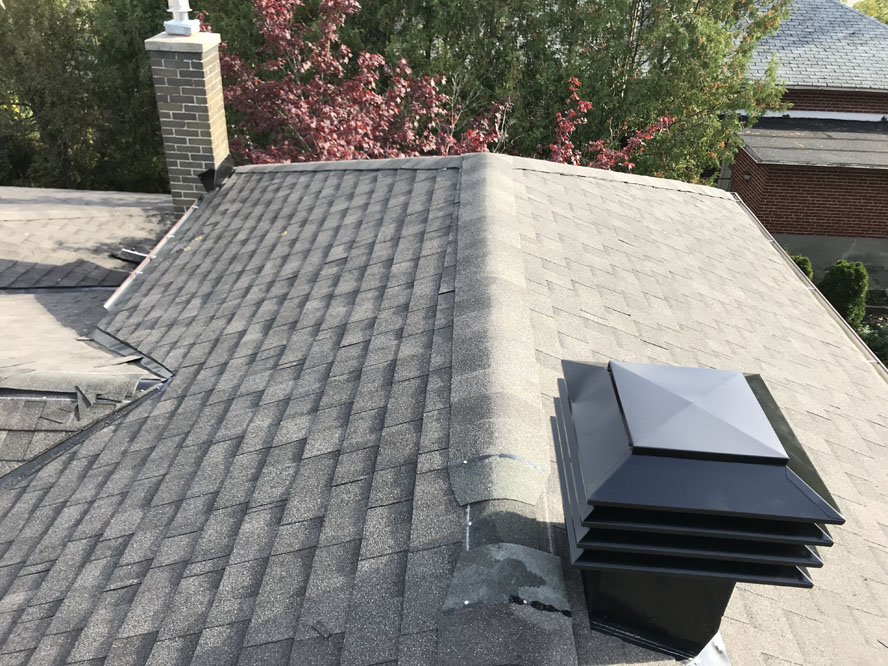Installing Roofing Underlayment/Roof Membrane
Re-Roofing Right. Why not install the roofing underlayment to the whole roof deck? Why not install it correctly? And why not use a roof underlayment that actually works and does what it is intended to do in the first place?
When re-roofing, roofers have a tendency to leave roofing underlay short at the roof edge when rolling it out (wind blown rain gets to the roof deck), or at the ridge of the roof (a ridge cap shingle cracks and a roof can leak), or don’t wrap their ridges and hips in underlayment hoping the shingles will perfectly do the job , or don’t run the roof underlayment or membrane up and under roof flashings, up and under skylight flashings, and wrap or neck tie roof penetrations with roof membrane such as roof vents, skylights, etc assuming that ice, snow, and water won’t back up under shingles and cause a roof leak.
Our roofing installation specifications call for the whole roof to be wrapped in underlayment or Ice & Water peel and stick membrane, and then we don’t have to worry about wind-driven rains, ice and snow backup, and ice dams at the roof edge or in valleys – all culminating in leaks. When we install a roof, the complete roof deck is wrapped in a “monolithic” style membrane specification and the roof cannot leak.
This specification includes running the roof underlay to the edge of the roof all the way, wrapping the ridge and hips into the underlay. -No part of the roof deck shows. Even on the coast, our roofs take punishing windstorms in places like Toronto.
Also, the roof penetrations (goosenecks, roof air vents, etc.) have Ice & Water membrane on the backside of the opening so that when ice, snow, and water build-up (ice damming) gets under the shingles, the roof underlayment is there to protect the roof from leaking and avoid roof repair. The same principle applies for installing a membrane at the wall and up & under skylight flashings (especially to the back side). Skylight leaks are one of the most common calls our emergency leak service receives.
Our roof installers also install Ice & Water peel and stick membrane to the valleys, right to the roof deck, and then metal valley flashing is installed on top of the membrane (even if the client wants a closed shingle valley, we still put metal flashing underneath the shingles), and then Ice & Water membrane is also installed to the top of the valley flashing edges so that when ice, snow, and water backs up in the roof valleys (ice damming which in Edmonton, Fort Mcmurray, Grand Prairie, Saskatoon, Regina, etc was so bad last winter) it can’t get back under the valley metal flashing and cause a leak.
At the roof eave we install Ice & Water membrane for ice, snow, and water back up at the gutters (last winter in Edmonton we had over 500 phone calls for ice damming at the eave on residential roofs alone – in one city during one winter!) – this is a primary area of concern for ice damming issues. The membrane sticks right to the roof deck and this avoids roof rot and roof leaks at the roof eave edge.
At the main area of the roof (the roof field) we use premium synthetic roof underlayment ( Premium Titanium Roof Underlayment ) which is twenty times stronger than roof felt underlay, it is lighter than tar felt paper, is recyclable, and doesn’t crack or rip at point of installation or from UV exposure.
If you (the homeowner that is getting your new roof) watched the roofing installation crew roll out felt paper at the point of re-roof installation, as seen right from the roof top… what actually occurs would cause you to never imagine EVER installing tar paper (felt paper) under your roof shingles. It cracks when the installers roll it out!
This happens before it is even installed, and then it somehow has to go up angles at skylights, etc. And then the staple hammer tackers start whacking thousands of staples into it – each time the hammer tacker hits, it also tears the tar paper felt, and if it is cold outside it is even worse, and then the shingle nailers start and on one house 7000 – 12000 roofing nails are installed right through that paper. And to top it off, if you have a shingle blow off due to wind, do you think the brittle tar paper will even stay on the roof if the shingle blew off? What protects your home at that point? WE DON’T USE ROOF TAR PAPER – FELT PAPER – ROOFING FELT on our pitched re- roofing installations period – NEVER.

 The roofers will have projects that they can show throughout the neighborhood. This way you can gauge their quality of work. You also want to ask for references of past clients the local roofers have rendered their services and ask how they did the job. Remember that not all local roofers may be reputable, so you need to check their performance before you make the decision.
The roofers will have projects that they can show throughout the neighborhood. This way you can gauge their quality of work. You also want to ask for references of past clients the local roofers have rendered their services and ask how they did the job. Remember that not all local roofers may be reputable, so you need to check their performance before you make the decision.